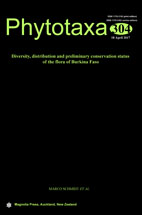Abstract
West Africa is a floristically understudied region that is facing severe environmental changes in the 21st century. Basic distribution data and information on the conservation status for most plant species of the region are scarce, and good information only exists for small areas of interest or for key species. This lack of knowledge seriously hampers urgently needed regional conservation efforts. Here we present comprehensive distribution information and preliminary, automated species conservation assessments for the flora of Burkina Faso, a country in tropical West Africa with a flora and vegetation typical for the savanna belt of the region. We documented and analysed the distribution of 1,568 species or 80% of the flora of Burkina Faso based on an expert curated dataset comprising ca. 150,000 occurrence records from herbarium specimens and vegetation surveys. We used this dataset and environmental niche models to calculate three indicator variables for a preliminary, automated conservation assessment. We classified 350 species (18% of the flora, excluding introduced species) as potentially "Critically Endangered", "Endangered", "Vulnerable" or "Near-Threatened" on the national level. The analyses confirmed species-rich areas in the south-west and south-east of the country, and showed a particular concentration of potentially Endangered species in the south. Furthermore, the proportion of potentially Endangered species differed between plant families, growth forms and habitats. Our results set the base for further plant geographical and ecological studies and are a data-driven baseline for further conservation assessments and large scale conservation strategies of the West African flora.

